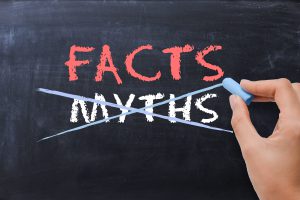Debunking Varicose Vein Myths
 There are many misconceptions surrounding varicose veins, particularly in regard to where they come from, who is at risk for them, and how to get rid of them. But we’re here to set the record straight about these and other common myths surrounding venous disease.
There are many misconceptions surrounding varicose veins, particularly in regard to where they come from, who is at risk for them, and how to get rid of them. But we’re here to set the record straight about these and other common myths surrounding venous disease.
• “Crossing your legs causes varicose veins.”
FALSE. The act of crossing one’s legs while sitting can certainly cause discomfort in patients already suffering from venous disease because it briefly constrains blood flow. However, this act itself does not cause varicose veins, which in fact originates from weakened or defective venous valves.
• “Only older women get varicose veins.”
FALSE. Although venous disease is more common in older patients and in women, no one is immune from varicose veins. They can and do occur in people of all ages, races, genders, shapes, and sizes.
• “All pregnant women get varicose veins.”
FALSE. Pregnancy can and does often cause varicose veins as a result of increased blood volume and weight. But varicose veins are avoidable before, during, and after pregnancy, often for women who do not have a family history of them, those who eat a balanced diet with lots of leafy greens, and those who get regular appropriate exercise like walking and bicycling.
• “There’s nothing you can do to prevent varicose veins because they are hereditary.”
FALSE. Much like many other genetically high-risk conditions, such as heart disease and certain cancers, venous disease can be prevented through proper diet, exercise, overall healthy lifestyle, and appropriate fashion choices. Just because your grandparents had varicose veins does not automatically mean the same fate for you. Conversely, if you think you’re in the clear because you don’t have a family history of varicose veins, think again. Poor lifestyle choices can make you just as susceptible to varicose veins as anyone else.
• “You don’t have to treat varicose veins unless they bother you.”
FALSE. Certainly, appearance is one of the more common reasons to have varicose veins treated, but in fact this condition does affect patients’ quality of life in noticeable ways and is also linked to higher risk conditions if left untreated, such as leg ulcers and deep vein thrombosis. Today’s treatment for varicose veins restores normal blood flow and alleviates symptoms immediately—and yes, they do look a lot better, as well.
• “You can easily see all your varicose veins on your body.”
FALSE. Despite being such a prevalent condition in both men and women, less than half display the bulging veins that are the most recognizable symptom. To begin with, fatty tissue that may be present between the muscle and skin can sometimes be enough to mask varicose veins. Moreover, other symptoms of varicose veins can be indicative of the more serious condition of chronic venous insufficiency, including leg swelling, pressure, aching, heaviness, restlessness, and itching. Patients who suffer from varicose veins may experience many of these symptoms but never display the ropey, bulging veins so commonly associated with the condition.
• “Varicose vein treatment is a long and painful process.”
FALSE. Years ago, the treatment for varicose veins was indeed a slow and painful process, often involving open surgery and long recovery. Today, removal of varicose veins can be done on a minimally invasive, outpatient basis. Patients can resume their normal activities within a day or two, and normal exercise routines within about a week following the procedure. There is little visible evidence that they even had varicose veins or a procedure to remove them, save for a few temporary bruises.
Be smart and spread the truth about varicose veins causes and treatments. The truth will set you—and your legs—free!